-
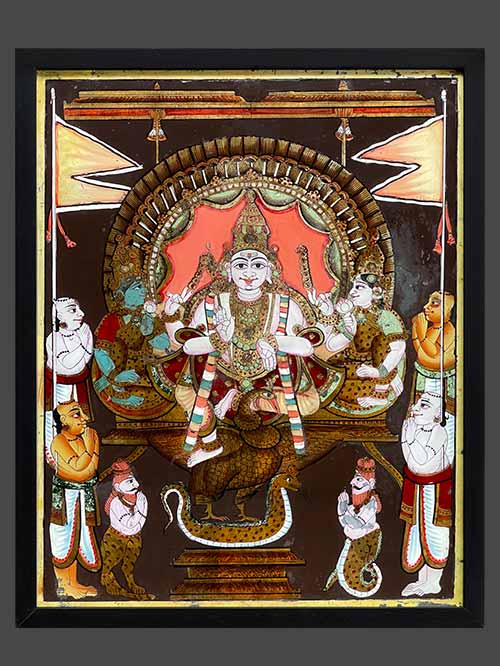
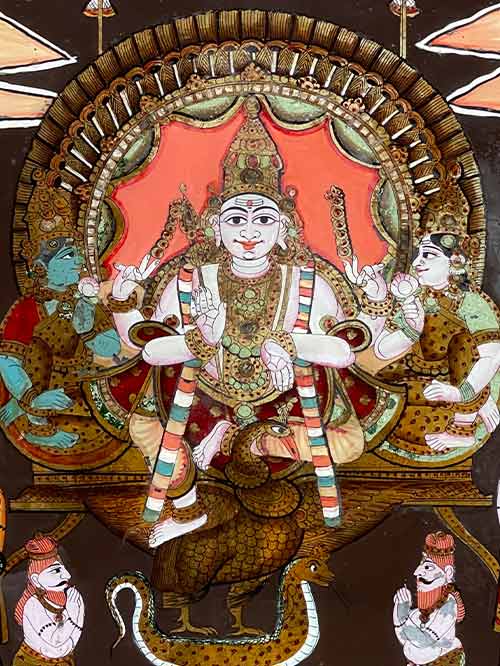
Tanjore (South India)
reverse painting on glass
Kartikeya (also known as Subrahmanyam, Murugan or Skanda) sits on a throne held up by his conveyance, the peacock. His consorts, the fair Devasena on his left and the blue-complexioned Valli on his right, are seated by his side. The realistically rendered tail of the peacock frames the trio and doubles as a ritual prabhavali. The peacock stands majestically with its talons firmly planted on a cobra. Set against a brown background, flags define the sides of the painting where four Brahmin devotees pay homage to the divine group along with the sages Patanjali on the right and Vyaghrapada on the left.
Reverse glass paintings were introduced into India the late 18th century from China by way of the China Trade. Indian artists adopted the technique of reverse glass painting partly on account of its novelty and also because it was a relatively inexpensive medium which could produce rich effects. The technique proved extremely popular and soon spread through western and southern India and even to former provincial Mughal capitals of Oudh, Murshidabad.
In Tanjore – a small state with an old art tradition- a distinctive school of glass painting developed in the early 19th century and continued for more than a hundred years. The style was essential Indian – it tended to repeat patterns of regional painting: images of deities, portraits and themes form the ancient myths, secular themes such as portraits of kings or nobles, courtesans and musicians. The colour was rich and the style bold and defiant. The subjects were clearly presented with a certain opulence and glamour.
Painting Size (cms): 50(H) x 40(W)
Painting Size (inches): 19.75(H) x 15.75(W)
Framed Size (cms): 54(H) x 44(W) x 4(D)
Framed Size (inches): 21.5(H) x 17.5(W) x 1.5(D)
-

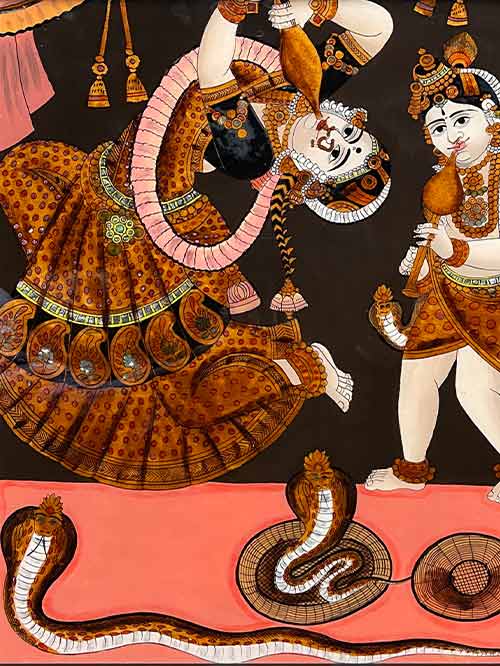
Tanjore (South India)
reverse painting on glass
A charming reverse glass painting depicting a Krishna and Yashoda as snake charmers each hypnotising a cobra with the melodic sounds of their fluted instruments called pungis. The adolescent Krishna is bejewelled and splendidly clad in a lower garment with a hip-hugging sash and a garland of flowers around his neck. His foster-mother Yashoda who is also gorgeously robed and jewelled contorts around to befuddle the snakes.
Reverse glass paintings were introduced into India the late 18th century from China by way of the China Trade. Indian artists adopted the technique of reverse glass painting partly on account of its novelty and also because it was a relatively inexpensive medium which could produce rich effects. The technique proved extremely popular and soon spread through western and southern India and even to former provincial Mughal capitals of Oudh, Murshidabad.
In Tanjore – a small state with an old art tradition- a distinctive school of glass painting developed in the early 19th century and continued for more than a hundred years. The style was essential Indian – it tended to repeat patterns of regional painting: images of deities, portraits and themes form the ancient myths, secular themes such as portraits of kings or nobles, courtesans and musicians. The colour was rich and the style bold and defiant. The subjects were clearly presented with a certain opulence and glamour.
Painting Size(cms): 47 (H) x 43.2 (W)
Painting Size(inch): 18.5 (H) x 17 (W)
Framed Size (cms): 49.5(H) x 46(W)
Framed Size (inches): 19.5(H) x 18(W)
-
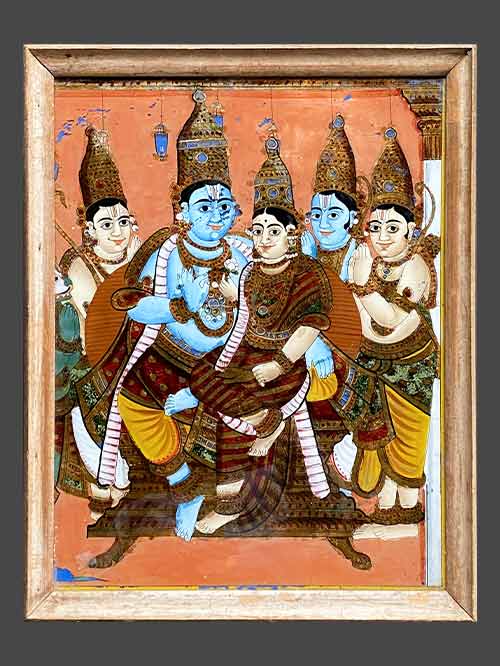
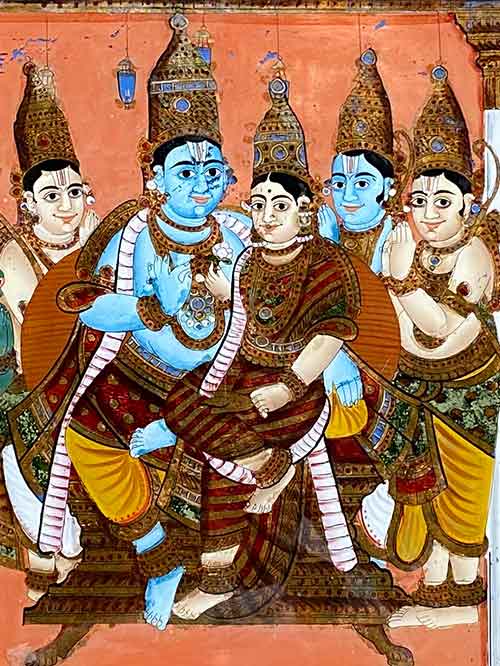
Tanjore (South India)
reverse painting on glass
The central group consists of Rama seated in lalitasana on a gilded throne with Sita on his lap. Lakshmana stands immediately behind him to the left; a blue-complexioned Bharata and Shatrugna stand behind Sita on the right. Rama, the hero of the Hindu epic Ramayana, was a king of Ayodhya and is regarded as an ideal ruler and a paragon of virtue. He is considered an avatar of Lord Vishnu. Rama’s journey portrays his unwavering devotion to his wife Sita and his ultimate triumph over the demon king Ravana.
Reverse glass paintings were introduced into India the late 18th century from China by way of the China Trade. Indian artists adopted the technique of reverse glass painting partly on account of its novelty and also because it was a relatively inexpensive medium which could produce rich effects. The technique proved extremely popular and soon spread through western and southern India and even to former provincial Mughal capitals of Oudh, Murshidabad.
In Tanjore – a small state with an old art tradition- a distinctive school of glass painting developed in the early 19th century and continued for more than a hundred years. The style was essential Indian – it tended to repeat patterns of regional painting: images of deities, portraits and themes form the ancient myths, secular themes such as portraits of kings or nobles, courtesans and musicians. The colour was rich and the style bold and defiant. The subjects were clearly presented with a certain opulence and glamour.
Framed Size (cms): 48.25(H) x 38(W)
Framed Size (inches): 19(H) x 15(W)
-
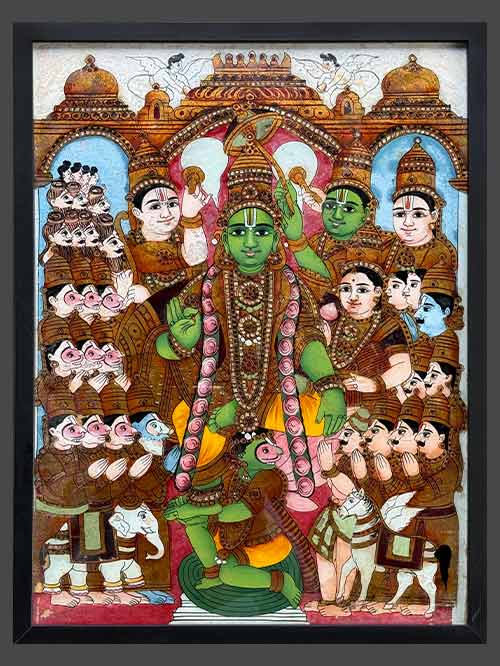
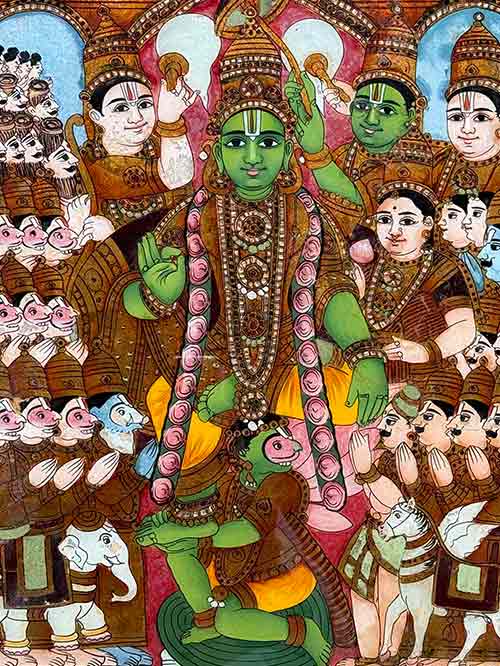
Tanjore (South India)
reverse painting on glass
Rama’s coronation, Ramapattabhisheka, is one of the most popular themes of South Indian painting. The central group consists of Rama seated in lalitasana on the throne with Sita to his left; Lakshmana carrying a chamara (fly whisk) standing immediately behind him; a green-complexioned Bharata carrying a parasol standing behind Sita; Shatrugna with a fly whisk to Bharata’s left and finally, in the foreground, Hanuman lovingly supporting Rama’s right foot. On either side are groups of attendees. The group on the left consist of ascetics, the monkeys and Jambavan — here recognisable by his blue snout. On the right are a number of courtly figures. Among them should be Vibhishana, the new king of Lanka, who helped Rama in defeating Ravana, but not readily recognisable here.
Reverse glass paintings were introduced into India the late 18th century from China by way of the China Trade. Indian artists adopted the technique of reverse glass painting partly on account of its novelty and also because it was a relatively inexpensive medium which could produce rich effects. The technique proved extremely popular and soon spread through western and southern India and even to former provincial Mughal capitals of Oudh, Murshidabad.
In Tanjore – a small state with an old art tradition- a distinctive school of glass painting developed in the early 19th century and continued for more than a hundred years. The style was essential Indian – it tended to repeat patterns of regional painting: images of deities, portraits and themes form the ancient myths, secular themes such as portraits of kings or nobles, courtesans and musicians. The colour was rich and the style bold and defiant. The subjects were clearly presented with a certain opulence and glamour.
Framed Size (cms): 64(H) x 49(W)
Framed Size (inches): 25.25(H) x 19.25(W)
-
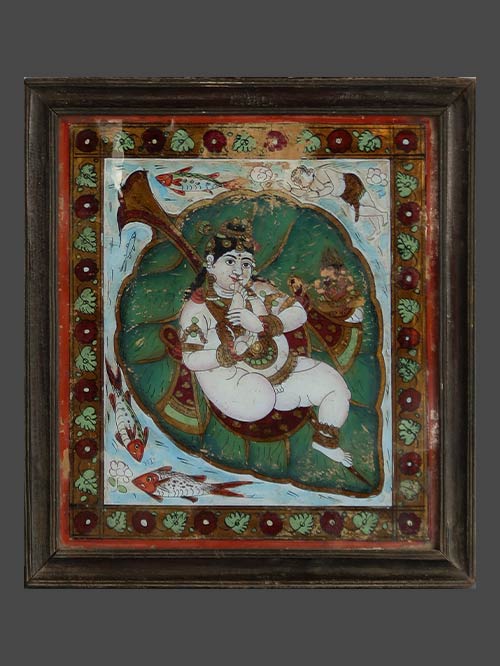
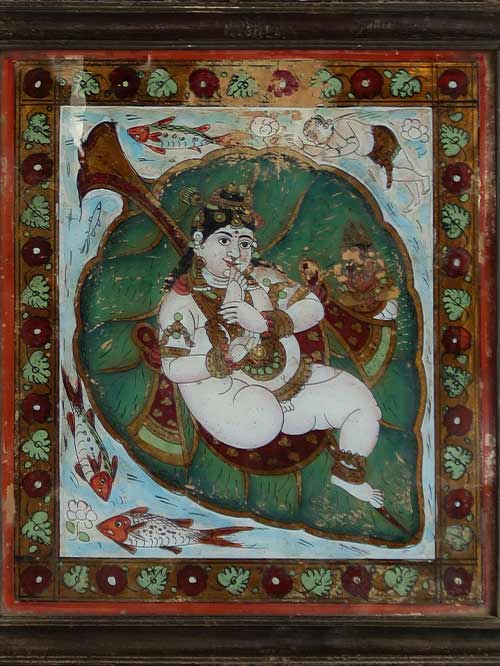
Tanjore (South India)
reverse painting on glass
Krishna as a child lies on a giant banyan leaf content, innocent, with a hint of amusement on his face. Naked but for his jewellery and a draped angavastra, he is depicted sucking his raised toe. As always, he is shown as a chubby child. The leaf he rests on is encircled by a school of fish, swimming amidst the primordial waters. Depicted on the top right is the sage Markandeya reaching out for the safety of the banyan leaf. A diminutive Brahma hovers above Krishna’s left foot. A border of leaves and roundels frames the scene.
The story of Krishna as Vatapatrasayi, or the Lord of the Banyan Leaf, occurs during the end of the world when the sage Markandeya sees the destruction caused by the great flood. In the midst of the chaos, he sees a small child floating on a banyan leaf, sucking his raised toe. Markandeya is drawn into the child’s body where he discovers the entire world, with all its realms, contained within the child who is oblivious to the disaster happening outside. The sage then realises that the child is a god who has taken the world into himself before recreating the universe.
Reverse glass paintings were introduced into India the late 18th century from China by way of the China Trade. Indian artists adopted the technique of reverse glass painting partly on account of its novelty and also because it was a relatively inexpensive medium which could produce rich effects. The technique proved extremely popular and soon spread through western and southern India and even to former provincial Mughal capitals of Oudh, Murshidabad. In Tanjore a distinctive school of glass painting developed, with a rich colour and bold and defiant style. The subjects were clearly presented with a certain opulence and glamour.
Framed Size (cms): 46.5(H) x 41.5(W)
Framed Size (inches): 18.5(H) x 16.5(W)
Painting Size (cms):39.5(H) x 31.5(W)
Painting Size (inches):15.5(H) x 12.5(W)
-
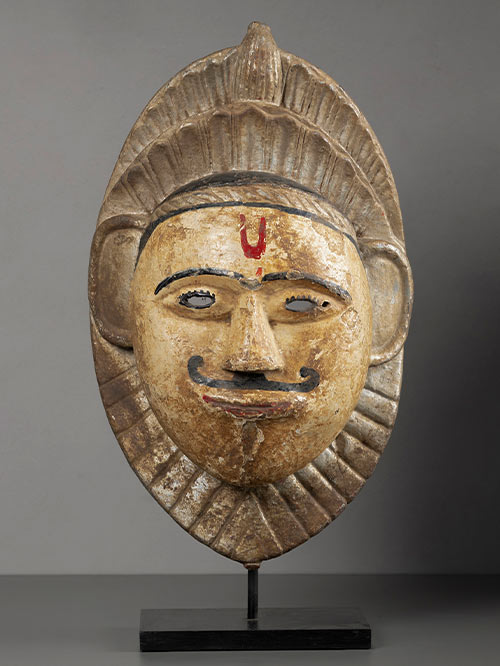
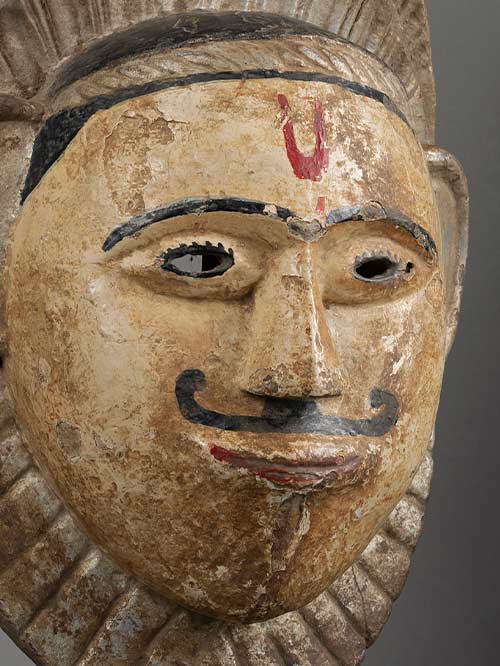
Konkan region (Karnataka)
Wood with traces of polychroming
An unusual painted dancing mask with excellent patina. It has pierced eye openings, protruding ears and large upturned moustache over a simpering grin. A brilliant red Vaishnavite tilak marks his the forehead. The figure wears an extremely unusual tiered and recessed crown that encircles the head and forms a stylised beard.
The Kokna are a major tribe found in Gujarat, Maharashtra, Karnataka, Rajasthan. The tribe carve masks representing mythological characters for the Bhavada festival. This festival is a combination of dance and drama, celebrated during March and April. The masks were carved from soft wood which allows an intricate detailing of various facial expressions. Modern masks are now made from Papier-mâché as they are lighter and more durable.
The characters of the tribal masks represent either deities including Vishnu, Ravana and Ganesha, ancestral spirits, totem, mythological character, animals and birds. Every dancer enacts steps typical of the character whose mask he wears, as he dances to the tune of musical instruments like the Sur, Kahali and Sambal. During the festival procession, masked dancers enact myths from tribal folklore as well as Hindu epics such as the Ramayana and Mahabharata.
Mask Size (cms): 58 (H) x 34 (W) x 19(D), 64 (H with stand)
Mask Size (inches): 14 (H) x 8.25 (W) x 6.5 (D), 25 (H with stand)
-
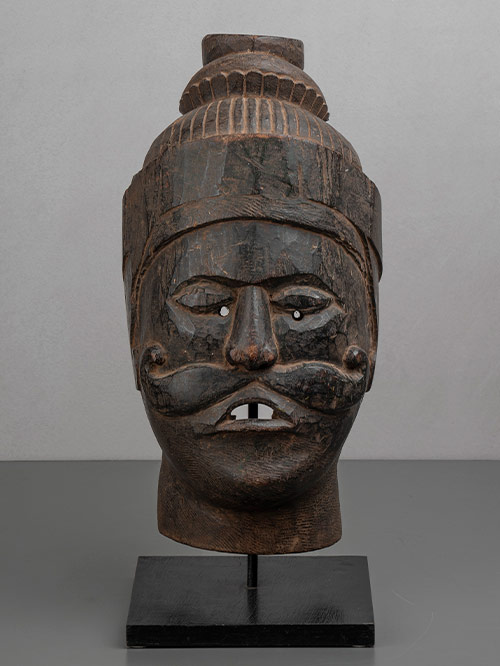
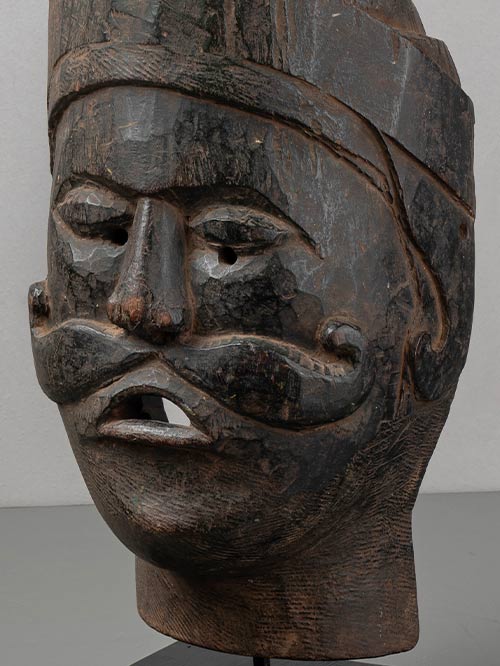
Konkan region (Karnataka)
Wood
An unusual unpainted dancing mask of a male figure worn during performances by members of the Kokna tribe. The stylised face wears a tiered crown and has a prominent upturned moustache sitting over its open mouth. Tiny circular eye holes have been cut out beneath the eyes to help the dancer navigate while wearing the mask.
The Kokna are a major tribe found in Gujarat, Maharashtra, Karnataka, Rajasthan. The tribe carve masks representing mythological characters for the Bhavada festival. This festival is a combination of dance and drama, celebrated during March and April. The masks were carved from soft wood which allows an intricate detailing of various facial expressions. Modern masks are now made from Papier-mâché as they are lighter and more durable.
The characters of the tribal masks represent either deities including Vishnu, Ravana and Ganesha, ancestral spirits, totem, mythological character, animals and birds. Every dancer enacts steps typical of the character whose mask he wears, as he dances to the tune of musical instruments like the Sur, Kahali and Sambal. During the festival procession, masked dancers enact myths from tribal folklore as well as Hindu epics such as the Ramayana and Mahabharata.
Mask Size(cms): 43 (H) x 22 (W) x 15 (D), 48 (H with stand)
Mask Size(inches): 16.9 (H) x 8.7 (W) x 5.9 (D), 18.9 (H with stand)
-
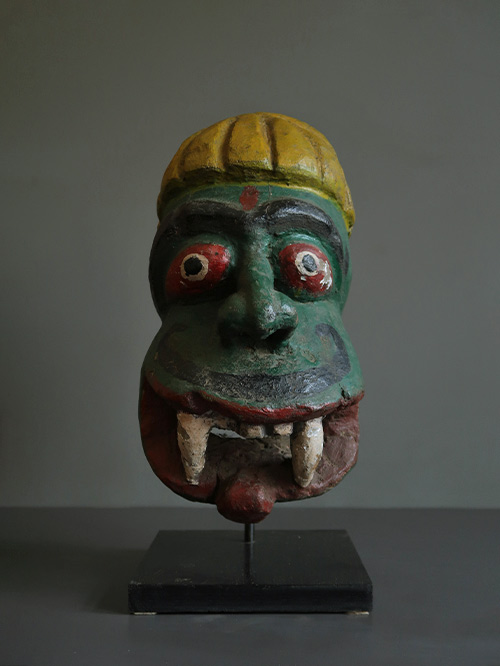
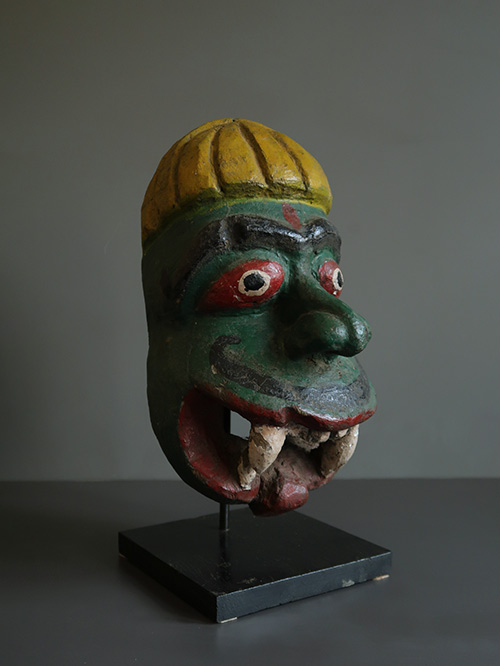
Maharashtra
wood, polychromed
Masks are very popular among the Kukanas and the Warlis of Gujarat and Maharashtra. They are used on ceremonial occasions when dramas are performed to the accompaniment of music and dance. During the festivals of Holi and Diwali mask-shows are organised by itinerant tribal artists in different villages. They serve the purpose of tribal unity and stability and to inculcate respect for tribal traditions and ancestors. When wearing a mask, the tribal artist first decides on the size of the mask—generally larger than the human face— and the fills in details. Painting on the mask is done not as part of the enrichment of the sculpture, but as a means by which the spirit is infused into the mask and thus it comes to life. Traditionally, masks were created out of fear of the natural power around them. People copied the world of animals and birds through symbols, paintings and sketches around them. The fear of the dynamism of nature within and outside, propelled them to create mask as a linkage between his world and the one unknown to him. Masks were treated as instruments of revelations- a pathway to the world of gods and other invisible powers- by giving form to the formless.
Mask Size (cms): 37 (H) x 18 (W) x 22 (D), 45 (H with stand)
Mask Size (inches): 14.6 (H) x 7 (W) x 8.7 (D), 17.7 (H with stand)
-
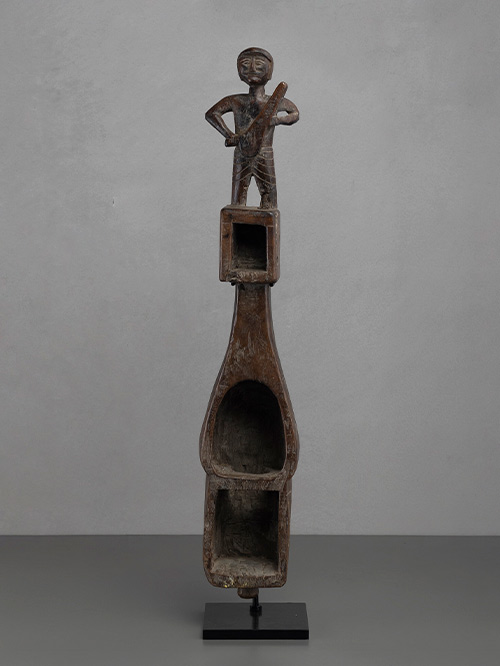
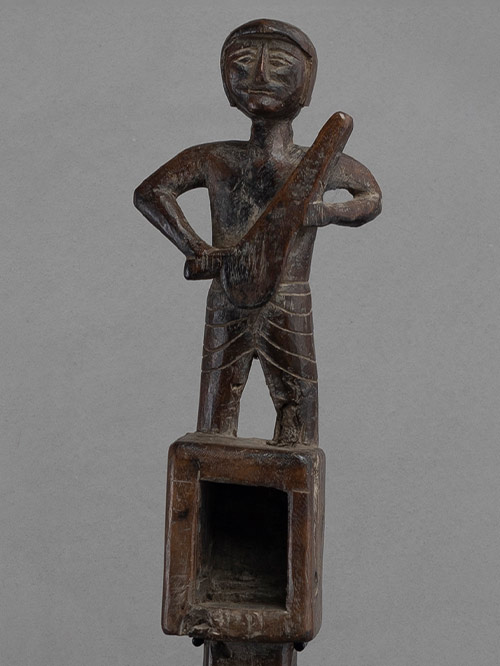
Santhals (North-Eastern India)
wood
An unusual instrument designed with a finial above the peg box depicting a standing figure playing a Dhodro banam instrument.
The Santhals are the largest tribal community who live in the Indian states of Bihar, Orissa and West Bengal. Music is an important part of Santhal culture and the Santhal are gifted and passionate dancers and musicians and most of their songs and dances are related to various seasons and phases of life. A variety of sculptural instruments are used by the tribe, the most unique of which are the dhodro banam (hollow instrument).
The Santhal believe they are physically related to the dhodro banam and consider the instrument to be a human being. The dhodro banam is made of a single piece of wood, divided as such into distinct body parts such as the belly flanked with arms, open ribcage and a long neck ending in a head. The head is the key block and is often beautifully carved in the shape of a human head, a couple or whole groups of humans or animals.
The dhodro banam player holds the instrument vertically with its neck pointing upwards and the playing hand above the bow hand. The bow (banam ak) is made with horsehair and the string, and when strung brings life into the instrument through its vibrations.
Size (cms): 70(H) x 13(W) x 13(D)
Size (inches): 27.5(H) x 5(W) x 5(D)
-
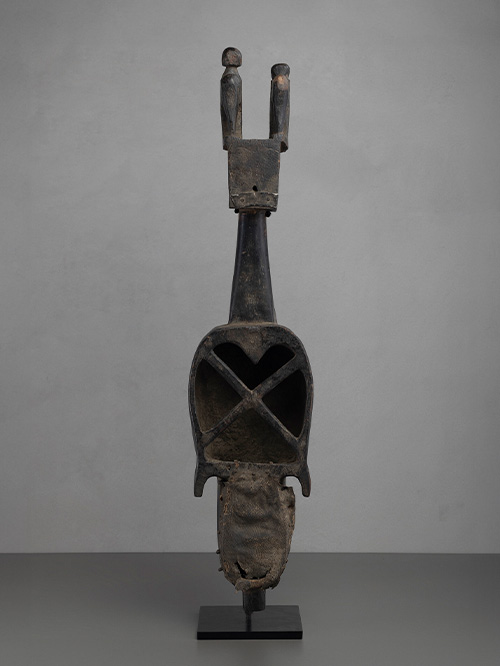
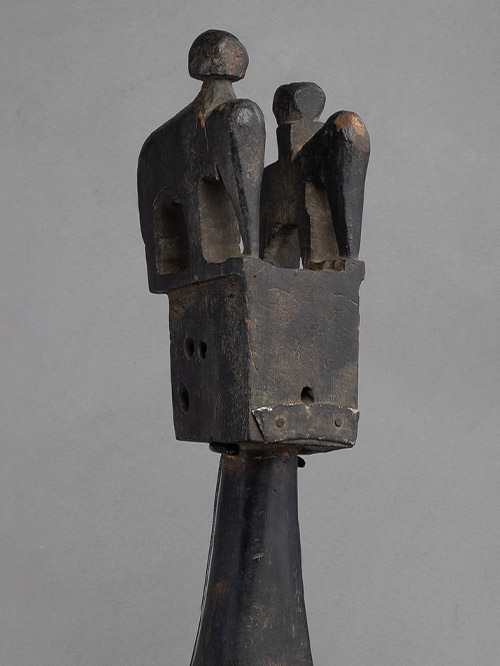
Santhals (North-Eastern India)
wood
A patinated wooden instrument, carved with a finial above the peg-box, depicting two riders atop elephants. The bottom half of the resonator is skin covered, most probably buffalo or goat hide.
The Santhals are the largest tribal community who live in the Indian states of Bihar, Orissa and West Bengal. Music is an important part of Santhal culture and the Santhal are gifted and passionate dancers and musicians and most of their songs and dances are related to various seasons and phases of life. A variety of sculptural instruments are used by the tribe, the most unique of which are the dhodro banam (hollow instrument).
The Santhal believe they are physically related to the dhodro banam and consider the instrument to be a human being. The dhodro banam is made of a single piece of wood, divided as such into distinct body parts such as the belly flanked with arms, open ribcage and a long neck ending in a head. The head is the key block and is often beautifully carved in the shape of a human head, a couple or whole groups of humans or animals.
The dhodro banam player holds the instrument vertically with its neck pointing upwards and the playing hand above the bow hand. The bow (banam ak) is made with horsehair and the string, and when strung brings life into the instrument through its vibrations.
Size (cms): 88(H) x 19(W) x 17(D)
Size (inches): 34.5(H) x 7.5(W) x 6.5(D)
-
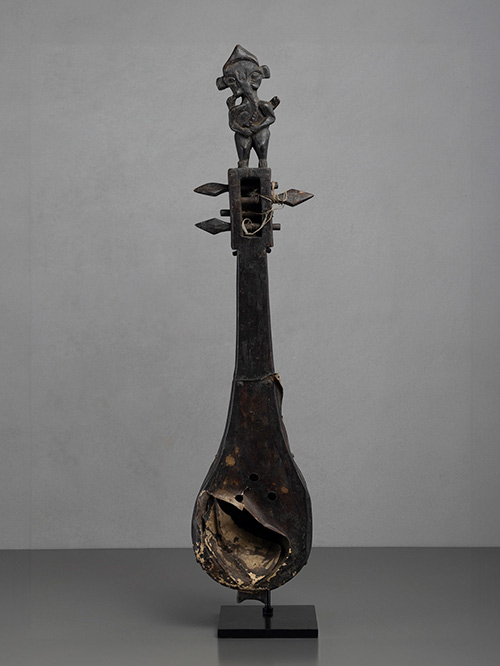

Santhals (North-Eastern India)
wood
A patinated and rare wooden instrument depicting Ganesha standing atop the peg box. The bottom half of the resonator is skin covered, most probably buffalo or goat hide.
The Santhals are the largest tribal community who live in the Indian states of Bihar, Orissa and West Bengal. Music is an important part of Santhal culture and the Santhal are gifted and passionate dancers and musicians and most of their songs and dances are related to various seasons and phases of life. A variety of sculptural instruments are used by the tribe, the most unique of which are the dhodro banam (hollow instrument).
The Santhal believe they are physically related to the dhodro banam and consider the instrument to be a human being. The dhodro banam is made of a single piece of wood, divided as such into distinct body parts such as the belly flanked with arms, open ribcage and a long neck ending in a head. The head is the key block and is often beautifully carved in the shape of a human head, a couple or whole groups of humans or animals.
The dhodro banam player holds the instrument vertically with its neck pointing upwards and the playing hand above the bow hand. The bow (banam ak) is made with horsehair and the string, and when strung brings life into the instrument through its vibrations.
Size (cms): 79(H) x 17(W) x 13.5(D)
Size (inches): 31(H) x 6.5(W) x 5.5(D)
-

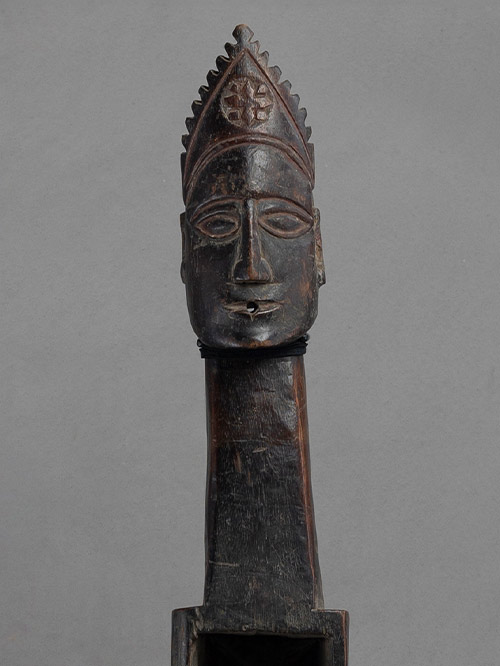
Santhals (North-Eastern India)
wood
A decorative and sculptural wooden instrument with an anthropomorphic form, featuring a peg box in the shape of a crowned head on top of a rectangular resonator. Fragments of the original resonator covering, most likely made from buffalo or goat hide, still remain on the lower half of the resonator.
The Santhals are the largest tribal community who live in the Indian states of Bihar, Orissa and West Bengal. Music is an important part of Santhal culture and the Santhal are gifted and passionate dancers and musicians and most of their songs and dances are related to various seasons and phases of life. A variety of sculptural instruments are used by the tribe, the most unique of which are the dhodro banam (hollow instrument).
The Santhal believe they are physically related to the dhodro banam and consider the instrument to be a human being. The dhodro banam is made of a single piece of wood, divided as such into distinct body parts such as the belly flanked with arms, open ribcage and a long neck ending in a head. The head is the key block and is often beautifully carved in the shape of a human head, a couple or whole groups of humans or animals.
The dhodro banam player holds the instrument vertically with its neck pointing upwards and the playing hand above the bow hand. The bow (banam ak) is made with horsehair and the string, and when strung brings life into the instrument through its vibrations.
Size (cms): 79(H) x 17(W) x 13.5(D)
Size (inches): 29(H) x 5(W) x 6(D)
-
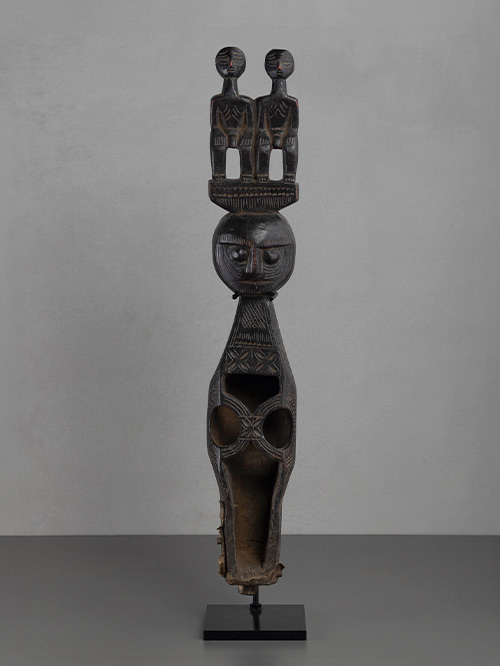
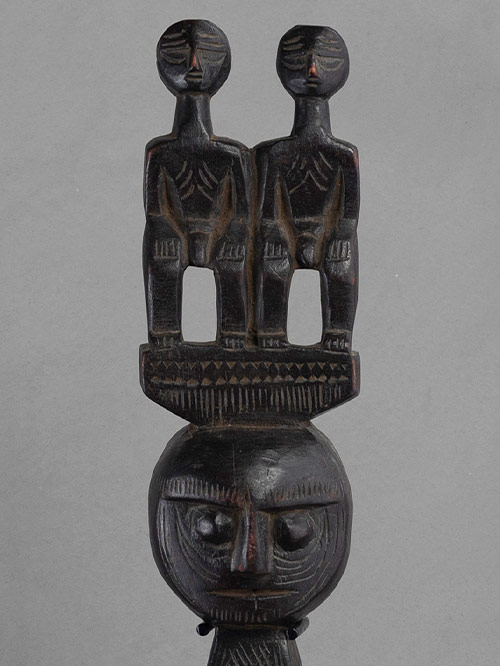
Santhals (North-Eastern India)
wood
This striking wooden instrument with an anthropomorphic form features a peg box in the shape of a tattooed head atop a shaped resonator. Atop the head, a finial depicts a pair of standing figures. Incised geometric and floral decorations cover every surface of the instrument. Traces of the original resonator covering, most likely made from buffalo or goat hide, still remain on the bottom of the resonator.
The Santhals are the largest tribal community who live in the Indian states of Bihar, Orissa and West Bengal. Music is an important part of Santhal culture and the Santhal are gifted and passionate dancers and musicians and most of their songs and dances are related to various seasons and phases of life. A variety of sculptural instruments are used by the tribe, the most unique of which are the dhodro banam (hollow instrument).
The Santhal believe they are physically related to the dhodro banam and consider the instrument to be a human being. The dhodro banam is made of a single piece of wood, divided as such into distinct body parts such as the belly flanked with arms, open ribcage and a long neck ending in a head. The head is the key block and is often beautifully carved in the shape of a human head, a couple or whole groups of humans or animals.
The dhodro banam player holds the instrument vertically with its neck pointing upwards and the playing hand above the bow hand. The bow (banam ak) is made with horsehair and the string, and when strung brings life into the instrument through its vibrations.
Size (cms): 74(H) x 13(W) x 18(D)
Size (inches): 29(H) x 5(W) x 7(D)
-

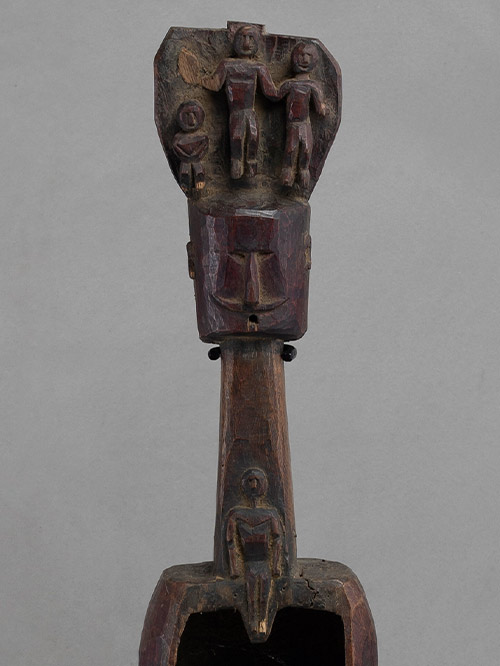
Santhals (North-Eastern India)
wood
This spectacular wooden instrument with an anthropomorphic form features a peg box in the shape of a moustachioed man atop a shaped resonator. Atop the head, a finial depicts three cheerful figures, potentially symbolising a family. The handle, worn from use, connects the peg box and resonator and is adorned with a depiction of a standing man. The original resonator covering, most likely made from buffalo or goat hide, still covers the lower half of the resonator. On either side of the resonator, intricate carvings feature a bird perched atop a tree.
The Santhals are the largest tribal community who live in the Indian states of Bihar, Orissa and West Bengal. Music is an important part of Santhal culture and the Santhal are gifted and passionate dancers and musicians and most of their songs and dances are related to various seasons and phases of life. A variety of sculptural instruments are used by the tribe, the most unique of which are the dhodro banam (hollow instrument).
The Santhal believe they are physically related to the dhodro banam and consider the instrument to be a human being. The dhodro banam is made of a single piece of wood, divided as such into distinct body parts such as the belly flanked with arms, open ribcage and a long neck ending in a head. The head is the key block and is often beautifully carved in the shape of a human head, a couple or whole groups of humans or animals.
The dhodro banam player holds the instrument vertically with its neck pointing upwards and the playing hand above the bow hand. The bow (banam ak) is made with horsehair and the string, and when strung brings life into the instrument through its vibrations.
Size (cms): 75(H) x 15(W) x 17(D)
Size (inches): 29.5(H) x 6(W) x 6.5(D)
-
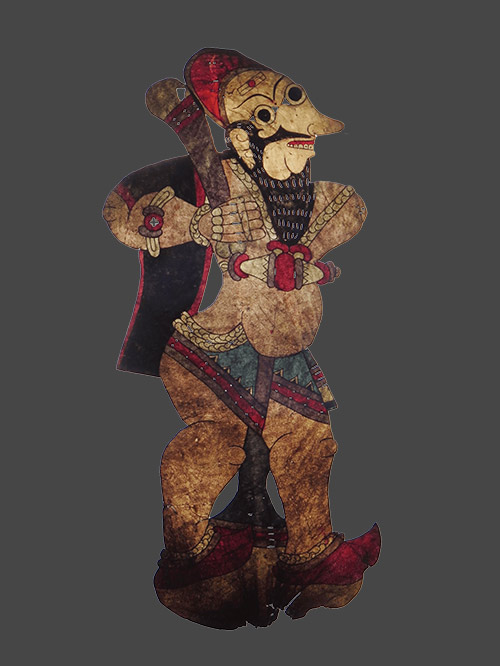
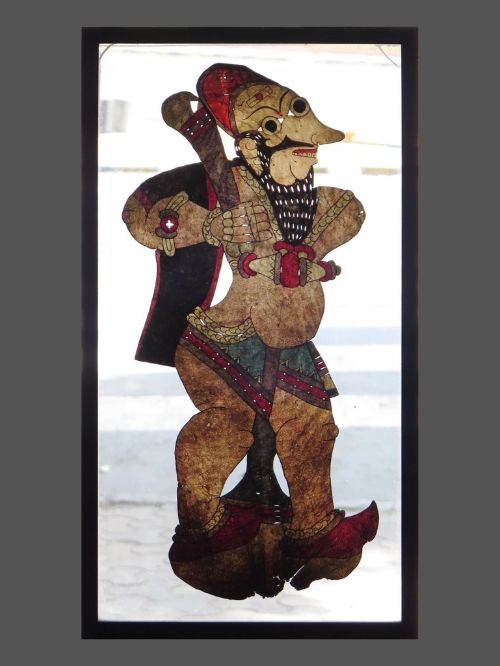
Karnataka (South India)
Framed Leather Shadow Puppet
The art of puppetry, called Togalugombayeta in Karnataka, involves acting out well known epic episodes using puppets made of flat leather pieces operated by a stick. The perforated leather is illuminated from behind, making this a form of shadow theatre. It is thought that the puppets were invented to avoid having gods and goddesses – who feature prominently in Indian epics like the Ramayana and Mahabharata – depicted by humans.
Size(cms): 69 (H) x 37 (L)
Size(inches): 27.2 (H) x 14.6 (L)
-
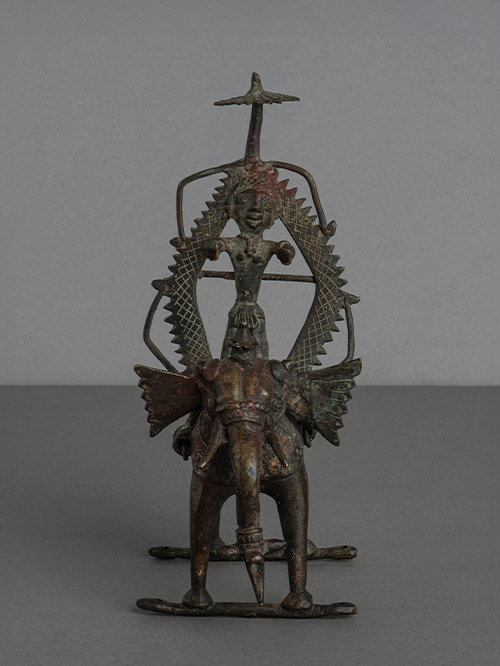
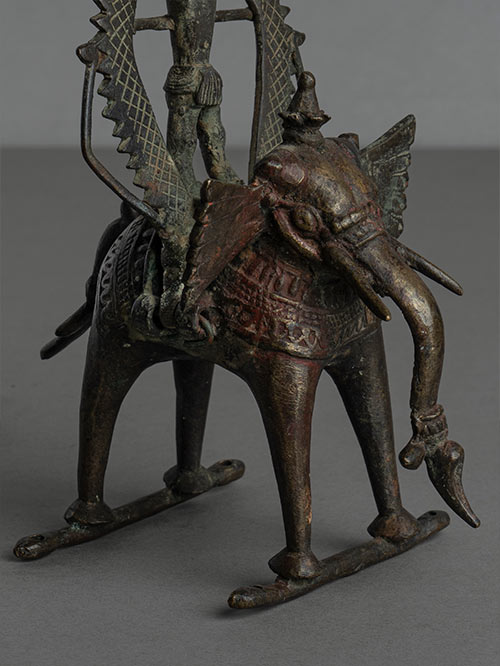
Orissa
brass alloy
A finely crafted figure of an elephant with its mahout. The caparisoned elephant is adorned with head and neck ornaments and a decorated saddle cloth, and it has a lovely curled trunk. Atop the elephant stands the Goddess Danteshwari, enclosed in a howdah shaped like a prabhavali, forming a ritual arch around the deity.
The elephant was the vahana or vehicle of god Indra. Later it became associated with deities such as Lakshmi and Danteshwari (Durga). In art and literature it became a symbol of power and might and was associated with royalty and deities. Danteshwari Mata who is a form of the powerful Goddess Durga and is also the family goddess of the princes of Bastar. The last ruler of Bastar who died in 1966 was considered her incarnation. The goddess was brought to Bastar in the 15th century by Annamdeo, an ancestor of the princely dynasty. On the run from the advancing Muslims, he had sought refuge in the impassable mountainous region of Bastar. Legend has it that the goddess appeared to him in through his royal sword and showed him the way. The sword represents the power of the victorious goddess and bestows military prowess upon its owner.
Size (cms): 19(H) x 12(W) x 8.5(D)
Size (inches): 7.5(H) x 4.5(W) x 3.5(D)

































